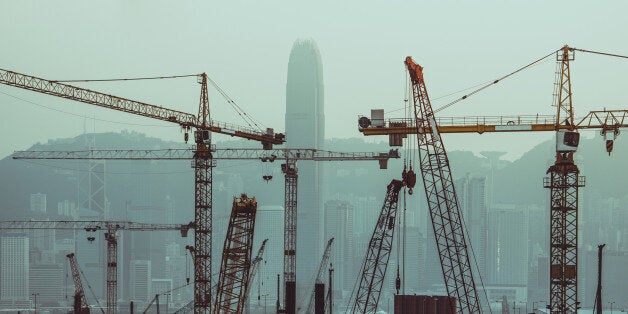
Sri Mulyani Indrawati, Managing Director and Chief Operating Officer, The World Bank Group
These remarks are excerpted from a speech to the International Conference on Urban China in Beijing on March 25, 2014
BEIJING -- 2011 was the year when, for the first time in history more than 50 percent of the people lived in cities.
By 2030, the global urban population will have doubled, adding 2 billion more people to cities. The size of built-up areas will have tripled from what it was in 2000. Every year, 20 million Chinese move into cities. That is 1.8 million a month, the equivalent of the cities of Hamburg or Vienna.
If managed well, urbanization can create enormous opportunities: allowing innovation and new ideas to emerge, saving energy, land and natural resources, managing climate and the risk of disasters. Globally, almost 80 percent of GDP is generated in cities. It will be difficult for any country to reach middle-income status and beyond without getting urbanization right.
Urbanization creates opportunities. But cities also consume around 70 percent of the world's energy and account for nearly 80 percent of global greenhouse gas emissions.
As we think about new approaches to urbanization here in China, we are also providing solutions for other countries facing similar issues. China's success in urbanization will lead the way for global solutions.
This type of sharing knowledge, capacity, and experience is vital to development success. We hope that the research the World Bank and the Development Research Center of China's State Council can and will be applied in cities like Lagos, Rio de Janeiro, Mumbai or elsewhere.
The Challenges
Over the past three decades, about 260 million migrants moved to China's cities. Many left poverty and farm work behind in favor of more productive and higher paying jobs. In 2030, just 16 years from now, up to 70 percent of all Chinese will live in cities. We are talking about one billion people who strive for success in functioning and sustainable urban settings.
China's urbanization supported the country's impressive growth and rapid economic transformation. And China avoided some of the common ills of urbanization, notably poverty, unemployment and slums. But despite the success, strains are starting to show. Many of them are familiar to you. Let me highlight the most pressing:
China's growth has been driven by investment rather than productivity. But investment has become less effective in generating growth both in cities and nationwide.
Urbanization has relied on land conversion and land financing, which is causing urban sprawl and, on occasion, ghost towns and waste.
Land conversion has added to inequalities, and has fed social unrest among farmers whose land has been expropriated, especially in peri-urban areas.
Barriers to migration have kept China's urbanization rate artificially low, curbing economic opportunities and widening urban-rural income inequality.
Citizens without urban household registration do not enjoy have equal access to public services in cities, another barrier to mobility.
Smog and poor water are putting the health of citizens and particularly their children at risk.
And finally, land-intensive urbanization has reduced farmland. It creates competition for water, adds to pollution, while undermining agricultural productivity and food security.
New Urbanization
China needs a new path to greater urbanization that will be efficient, inclusive and sustainable. Through better allocation of land, labor, and capital this new model can share the benefits of urbanization more widely than in the past. And it can be environmentally sustainable while ensuring China's food security.
This is why we call it 'New Urbanization.'
In this new model the government will have a different role. It will support rather than supplant market forces. It will allow China's cities to grow more organically and efficiently. New urbanization is not merely about bricks and mortar. It puts people at the center of the strategy.
New urbanization must be affordable and it will be. On current trends, China's cities would spend some $5.3 trillion on infrastructure over the next 15 years. But with more efficient, denser cities China can save some $1.4 trillion in infrastructure spending -- or 15 percent of last year's GDP.
New urbanization requires a comprehensive package of reforms, recognizing that the issues are closely intertwined. They have to be addressed comprehensively: Piecemeal reform will not solve the problems.
We have identified obstacles to reforms; suggest sequencing and quick wins -- steps that can make change happen. We analyze short-term risks, and propose participatory approaches to generate support and connect decision makers and citizens.
Together with a better revenue structure, this provides the space for higher government spending on social services for all migrants, while local borrowing can be brought down to more sustainable levels.
The Chinese government is already implementing many of the recommendations of our joint study. It focuses firmly on overcoming obstacles arising from increasing inequality, urban pollution and a slowdown of productivity and growth.
The vision is about people: providing services to all citizens in all cities, regardless of their residence permit; better city planning and better coordination with the interests of the people in mind.
Recommendations
Here is a brief overview of the six policy priorities the World Bank has identified for China, taking into account the realities of its political economy:
First, land management and ownership are among the most pressing issues. Because so much farmland was converted for urban expansions, the amount of available farmland has dropped to the "red line" of what is considered to be the minimum necessary to ensure China's food security. This trend must be reversed: Urbanization must no longer be driven by financing opportunities arising from land conversion.
Limits should be set up on rural land taken for public purposes by local governments. Efficient and equitable use and conversion of rural of land will require stronger property rights for farmers and appropriate compensation based on fair value. And urban land allocation needs to be driven by market prices as well.
Second, China needs a mobile and versatile labor force with equal access to quality services. The hukou system needs to evolve into a residency system over time. This will remove barriers to labor mobility from rural to urban areas, as well as between cities, and boost workers' wages. I am very pleased to see that the authorities have already announced a reform of this system and its application.
Third, place urban finances on a more sustainable footing and create financial discipline for local governments. The recent audit of local government debt is a call for action.
In the future a higher portion of local expenditures needs to be financed through local revenues, such as phased-in property taxes and adequate charges for urban services. Transparent financing will impose financial discipline on local leadership, making them more accountable to residents. Local governments will borrow, but within strict central government rules to avoid over-indebtedness.
Fourth, reforming urban planning and design will be critical. Moving towards market-driven pricing for industrial land can encourage land-intensive industries to move to smaller, secondary cities. Cities could move to flexible zoning, with smaller plots and more mixed land use, which would make them denser and more efficient. To accord smaller cities a stronger economic base and increase services, zoning needs to shift away from industries toward commercial and residential use. Linking transport infrastructure with urban centers and promoting coordination among cities would encourage better management of congestion and pollution.
Fifth, environmental degradation needs to be halted and reversed. China already has tough environmental laws, regulations and standards. China has also piloted many technical solutions to address pollution and increase resource use efficiency for many years that could be brought to scale. Now the most important task for achieving greener urbanization is vigorous enforcement of those standards. At the heart of this are better institutions and incentives. Better data collection and sharing will encourage greater public participation in holding polluters accountable.
Sixth and finally, improving local governance. The performance evaluation of local officials should give greater weight and incentives to successful urbanization.
Over the last three decades China has grown faster than any other country in the world. It has lifted over 500 million people out of extreme poverty. These are extraordinary achievements.
Ending extreme poverty by 2030 and promoting shared prosperity is our shared vision. China has shown the world that it is well on track to end poverty. It can build on this success by getting urbanization right and ensuring that all citizens will benefit from development and growth on an equitable basis.
